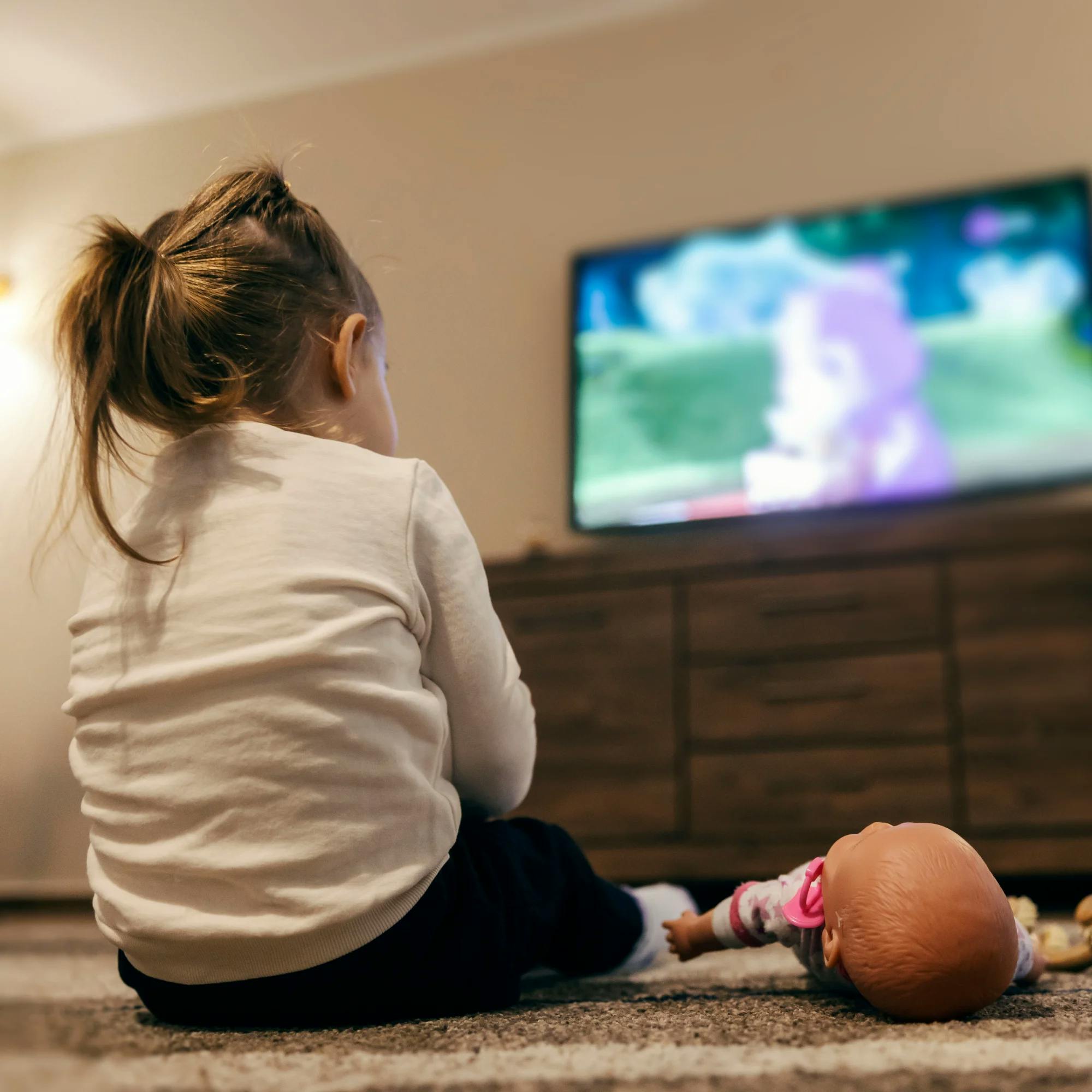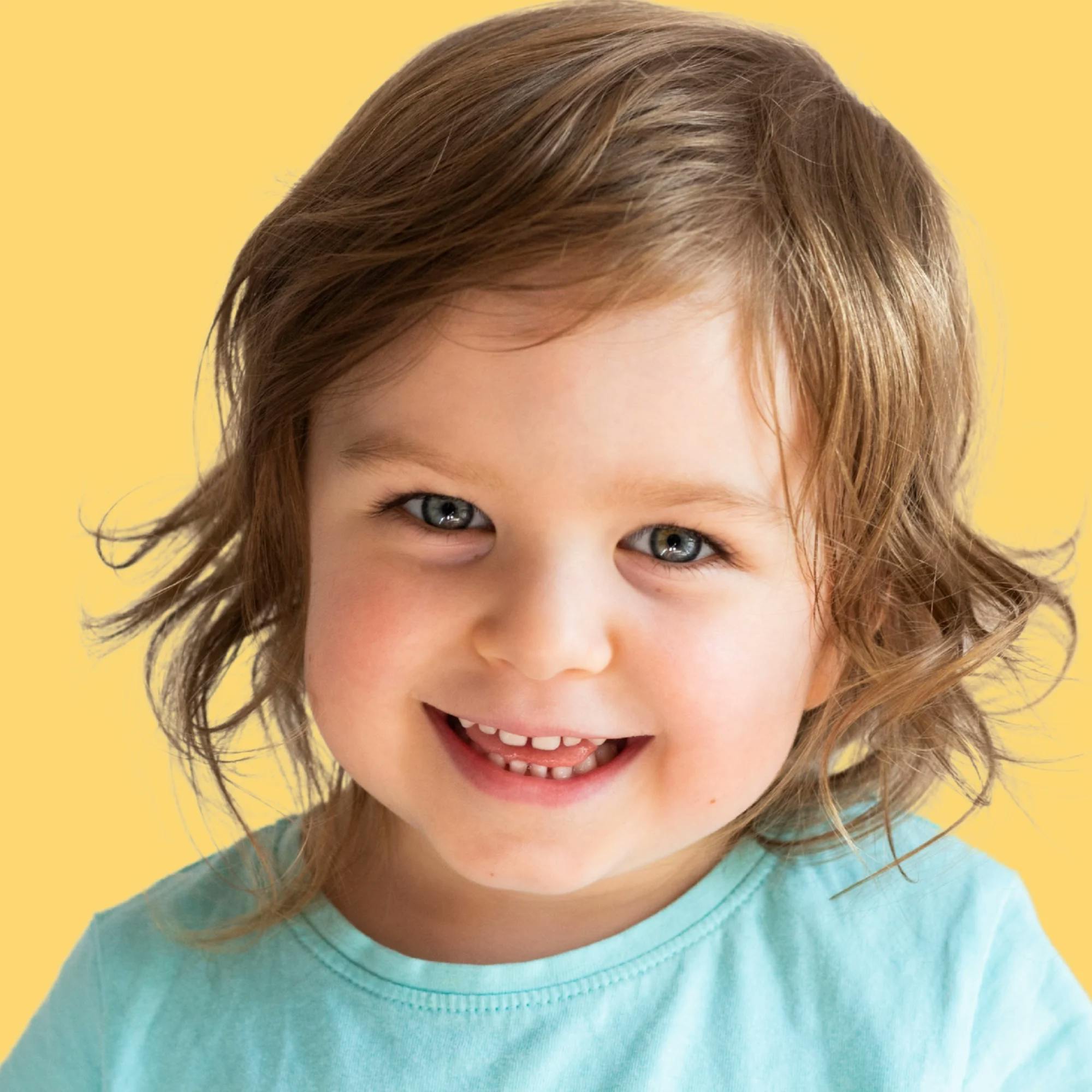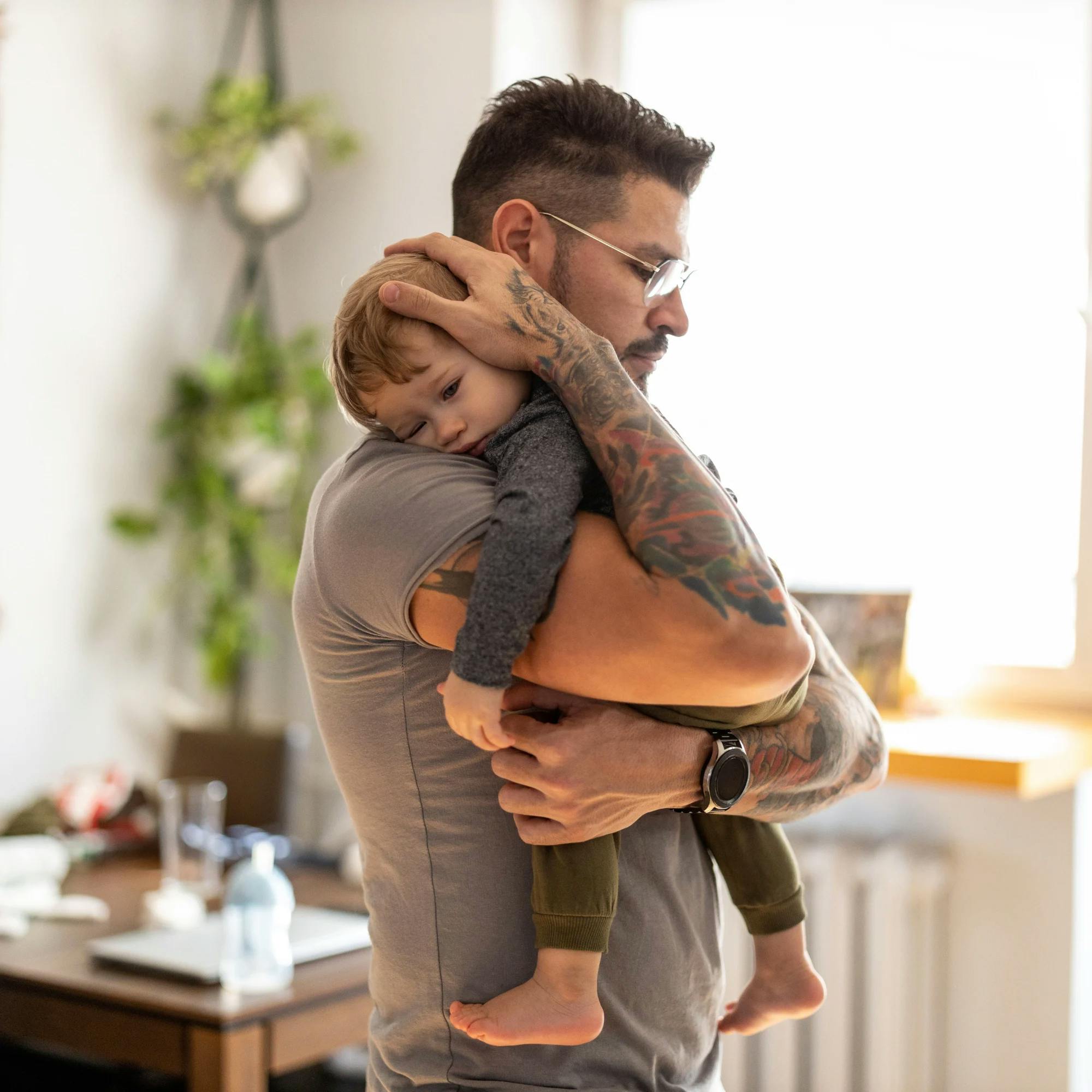With so many speech-focused apps, shows, and YouTube videos at our fingertips, it isn’t a surprise that some families rely on them to help teach their child to talk. It all seems like an easy, convenient way to learn new words and language concepts.
But do educational videos and shows for kids really work? Some of these online speech resources are helpful and clinically based. However, they can’t replace one-on-one speech therapy with a licensed speech-language pathologist. Let’s take a look at why that is, how children learn language, and when it makes sense to talk with a speech therapist.
Is your child on track?
Take our free screener to learn more about your child's development and whether a speech evaluation is recommended.
 Screener for children
Screener for childrenCan TV shows and videos teach your toddler to talk?
Many studies have been done to test the effectiveness of educational TV shows and videos aimed at young children. To date, the overall evidence doesn’t support the value of these shows.
For example, in this study, young children learned verbs by interacting with real people, not watching a screen. This study revealed that the main predictor of a child’s language growth was how often they were read to, as opposed to watching an educational show that taught common words. And in this study, it was the parent’s involvement in watching alongside their child and interacting with them that helped them learn new words.
It’s true that your toddler might watch a YouTube video and then start saying new words. But as children develop their speech and language, their skills need to move beyond imitating what’s on a screen.
Children learn best when they interact with a caring adult, who models language for them and responds when the child does or says something.
It’s important to consider the context in which the new speech skills are happening. For example, if your child can say “hi!” to a character on screen, but isn’t saying “hi” to other people in real life, that skill hasn’t transferred yet. It’s more beneficial for your child to work on that skill in daily interactions with people, rather than simply practicing it with a TV or tablet.
It all comes back to how babies and toddlers develop language. Children learn best when they interact with a caring adult, who models language for them and responds when the child does or says something. That back-and-forth interaction is key to speech and language development. It’s essentially what communication is! And watching a video doesn’t allow kids to learn in this way.


The effects of too much screen time
Of course, another downside to learning speech from videos is that it adds to the overall effects of too much screen time, especially in toddlers. Many studies have shown that greater amounts of screen time are linked to a higher likelihood of developmental delays in communication.
There is a difference between passive and active screen time, and some shows and apps are more educational than others. But even the highest quality videos still count toward screen time. And the more time your child spends sitting in front of a screen, the less time they spend interacting with the world around them.
Think about taking a walk around the neighborhood. If your child is in their stroller watching their favorite show on a tablet, they're missing an opportunity to interact with you, ask questions, point to objects, learn new words, and more. As described above, all of these activities build speech and language skills.


What can speech therapy give you that the Internet can’t?
What about speech therapy apps? You might be thinking, “Why would I pay for someone to help my child if I can get that help from speech apps or videos?” The truth is, we aren’t comparing apples to apples. Support from online resources and support from a speech therapist aren’t the same thing.
A licensed speech-language pathologist, also called a speech therapist, is trained to evaluate your child’s strengths and weaknesses. Based on that evaluation, they identify what your child needs to work on to improve their daily communication, along with the techniques and exercises to help them reach those goals.


Importantly, a speech therapist can identify and diagnose communication-related conditions. Speech therapists work with a variety of disorders, such as articulation and phonological disorders, lisp, speech delay, language delay, apraxia of speech, and stuttering. They also work with autistic children and children with ADHD. Many of these conditions have similar symptoms, although they require specific types of treatment.
Let’s take a look at some of the disorders that can benefit from individualized treatment by a speech therapist:
Articulation disorders
This is the inability to form clear sounds past a certain age. Word sounds may be distorted, added, dropped, or swapped altogether. Some common signs of an articulation disorder can include:
Errors due to differences in the orofacial structures (example: saying “hip” instead of “ship”)
Distorting sounds in words (example: saying "thith" instead of "this")
Swapping sounds in words (example: saying "wadio" instead of "radio")


Phonological disorders
A phonological process disorder is a regular pattern of mistakes in certain words. While this is common in children learning to talk, if it extends past a certain age it may mean a disorder. Signs of a phonological process disorder can include:
Saying only one syllable in a word (example: "bay" instead of "baby")
Simplifying a word by repeating two syllables (example: "baba" instead of "bottle")
Leaving out a consonant sound (example: "at" or "ba" instead of "bat")
Changing certain consonant sounds (example: "tat" instead of "cat")
Lisps
A lisp is a specific type of speech sound error. A lisp refers to a person’s difficulty in pronouncing the /s/ or /z/ sounds. This is because of an incorrect motor pattern of tongue positioning. When a person has a lisp, they are positioning their tongue in a way that blocks the airflow needed to make the /s/ and /z/ sounds. This distortion of airflow creates the lisping sound we are familiar with.
Receptive and expressive language disorders
A receptive language disorder is an impairment of the ability to understand language. Children may struggle to grasp the meaning of what people are saying. Or they may have trouble interpreting the context of written words when reading or writing. This can make it difficult to make sense of the world around them. A child with a receptive language disorder may have difficulty with:
Following simple conversation
Paying attention to tasks shared with another person
Identifying named objects/photos
Following directions
Understanding questions asked of them
A child with an expressive language disorder may be able to understand what's said to them, but they have trouble expressing what they need to say. They may struggle with learning and using new vocabulary words, stringing words together into clear sentences, or telling a story. An expressive language disorder can present in a variety of ways. Here are a few signs you may see in your child:
Grunting instead of using words
Difficulty gesturing to express their wants/needs
Limited amount of words in their vocabulary
Difficulty forming phrases and sentences
Difficulty with various areas of grammar
Poor ability to answer questions


Childhood apraxia of speech
Childhood apraxia of speech (CAS) is a motor-planning disorder. In fact, the root of the word, “praxis,” means “planned movement.” The person has the language capacity to talk, but the signals between their brain and mouth muscles aren’t sent correctly. A child with CAS may know exactly what they want to say, but their brain struggles to tell the muscles in their mouth how to move in order to make the right sounds.
Childhood apraxia of speech may sound like this:
Inconsistent errors in speech: A child with apraxia may pronounce the same word differently each time they say it.
Distorting sounds: Because people with apraxia do not place their mouth muscles in the right position, sounds often come out incorrectly.
Groping for sounds: People with apraxia can seem like they’re “groping” or struggling for words. They may try saying a word several times before they say it correctly.
Inappropriate intonation, stress, or rhythm of words: Kids with apraxia may struggle with the rhythm and flow of speech. They may segment syllables in a word, omit syllables in words, or pause inappropriately while speaking.
Difficulty with volitional movements: A person with apraxia may have a tough time initiating what they want to say, such as asking a question, as compared to more automatic speech, such as saying the alphabet


Stuttering
Stuttering, sometimes called stammering or disfluency, is a communication disorder that disrupts the natural flow of speech. Stuttering can begin gradually and develop over time, or it can appear suddenly. People who stutter often repeat certain syllables, words, or phrases ("li-li-like this"), prolong them ("lllllike this"), or experience abnormal stops of certain sounds and syllables. Here are some other common signs of stuttering:
Routinely using interjections, such as “um” or “like,” that disrupt the flow of speech
Talking slowly or taking a lot of pauses
Stopped or blocked speech; you may see your child’s mouth open, but nothing is being said
Fast eye blinking, trembling, or shaking lips when speaking
Increased stuttering when tired, excited, or under stress
Being afraid or nervous to talk
The importance of diagnosing your child’s speech issues
As you can see, there are a wide variety of speech and language conditions. Some are very different, while others appear to have similarities. This is where differential diagnosis becomes important.
Here’s an example. Let’s say your child is 3 years old and not talking much. It may be that they have an expressive language delay. However, some kids who appear to have a speech delay actually have childhood apraxia of speech. Not surprisingly, these conditions would be targeted differently in speech therapy, and a professional is needed for a diagnosis. It’s also important for speech therapy to begin as early as possible, while the child is still young.
Where to find a speech therapist near you
If you’re reading this and thinking your child might benefit from an evaluation, reach out to a speech therapist. It’s better to have an evaluation done and learn that your child doesn’t need intervention, rather than waiting too long and keeping your child from important time in speech therapy.
There are many places to search for a speech therapist. Expressable offers a large national team of licensed speech therapists with a range of specialities. We match you with a speech therapist for an evaluation based on your child’s needs and your family’s schedule. Therapy sessions can be done on weekdays, weekends, and in the evening, and with online speech therapy, there’s no commute involved.
Other sources for speech therapy include:
Doctor or pediatrician recommendation: Your health care provider may be able to give you a referral to a local speech therapist.
Insurance company: If you have health insurance, contact them to better understand their policies and coverage for speech therapy. They may have a list of in-network speech therapy providers that you can research and contact.
Online directories: There are several online directories where you can search for speech therapists by location and qualifications. One of these directories is compiled by the American Speech-Language-Hearing Association (ASHA), which is the professional credentialing organization for speech-language pathologists.
Colleges: Receiving therapy from a college student studying to become a speech therapist is an affordable option for some families.
As a parent, you have a lot on your plate. But if your gut is telling you that your child may need help with their speech and language, talk with a speech therapist to get your questions answered. If your child needs speech therapy, the sooner they can begin, the better!
How Expressable Can Help
Concerned your child isn't reaching age-expected milestones? Looking for communication support from a professional? Expressable is a national online speech therapy practice serving children and adults. We treat all major areas of communication and feeding, offer flexible hours including evenings and weekends, and accept most major health insurance plans. We’re proud to have earned more than 3,000 5-star reviews from our clients (4.9/5 average).
Our therapy model is centered on parent and caregiver involvement. Research proves that empowering caregivers to participate in their loved one’s therapy leads to better outcomes. That’s why we combine live, 1-on-1 speech therapy with personalized education and home practice activities for faster progress.
Communication is more than words. It’s how we share how we feel and show who we are. We’re here to help you or your child do just that.

 Abby Barnes, M.S., CCC-SLP
Abby Barnes, M.S., CCC-SLP








